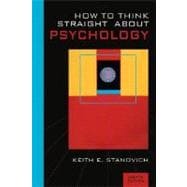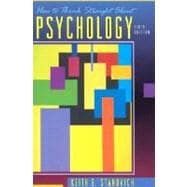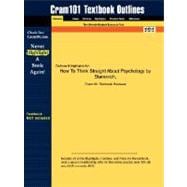How to Think Straight About Psychology

How to Think Straight About Psychology
- ISBN 13:
9780205485130
- ISBN 10:
0205485138
- Edition: 8th
- Format: Paperback
- Copyright: 01/01/2010
- Publisher: Prentice Hall
- Newer Edition
Rent
Sorry, this item is currently unavailable.
Note: Supplemental materials are not guaranteed with Rental or Used book purchases.
Extend or Purchase Your Rental at Any Time
Need to keep your rental past your due date? At any time before your due date you can extend or purchase your rental through your account.
Summary
Keith Stanovich's widely used and highly acclaimed book helps instructors teach critical-thinking skills within the rich context of psychology. It can be used as a stand-alone text or as a supplement in introductory psychology, critical-thinking, as well as research methods and statistics courses. It is the premier text of its kind. Stanovich helps students become more discriminating consumers of psychological information by helping them recognize pseudoscience and be able to distinguish it from true psychological research. Psychological topics such as falsifiability, operationalism, experimental control, converging evidence, correlational vs. experimental studies, and statistics are presented as tools for critical evaluation, giving students a set of practical consumer skills to independently evaluate psychological claims. Students also are given a set of "consumer rules" for dealing with psychology in the media. How to Think Straight About Psychology says what many instructors would like to say about the discipline of psychology but haven't found a way to. That is one reason adopters have called it "an instructor's dream text" and often comment "I wish I had written it. It tells my students just what I want them to hear about psychology." New to the eighth edition are expanded discussions of reliability and validity, meta-analysis, and the differences between random sampling versus random assignment.












